Contents
Watering onions from worms is carried out with chemical preparations, and during fruiting – with biological and folk remedies. If there are too many pests, it is worth using the most powerful insecticides and acaricides. A description of the main pests and methods for their destruction are presented in the article.
Reasons for the appearance of worms in onions
If worms are wound up in the onion or directly in the root crop, the causes of the invasion can be associated with various factors:
- lack of digging in the fall;
- the bulb has not been disinfected;
- there is no alternation of onion beds with carrots.
- violation of crop rotation (the plant is grown for several years in a row in one place).
Types of worms and symptoms of damage
There are quite a few types of worms that eat onions. They belong to different classes, including insects, mites and worms. The main types of pests and a description of the symptoms of the lesion are presented below.
Onion fly larva
This is one of the most common, very dangerous pests. If white worms with a shade of “dirty” appeared in the onion, only 1-2 mm long, these are the larvae of the onion fly. Adults reach 8 mm, they have yellow oblong wings. The body color is gray, close to ashy.

Pests lay eggs on seedlings and in the surface layer of the soil.
From these eggs, larvae appear after 4-6 days. They move into the rhizome and feed on them. The main signs of the invasion:
- mass plantings wither even when the first leaf appears;
- dirty white larvae visible on the soil surface;
- worms also appear in green onions – small holes are noticeable in feathers, as well as in turnips;
- roots begin to rot.
Wireworm
The wireworm is the larva of the click beetle. This is another worm that infects onions, so even at the beginning of the invasion, it is necessary to water the plantings with preparations. The development cycle is long, taking several years. All this time, the worms are in the soil, they do not come to the surface and at the same time constantly hit the plantings. This is noticeable in the following ways:
- the stems dry up;
- holes appear in the bulbs;
- plants lag behind in development, look sluggish.
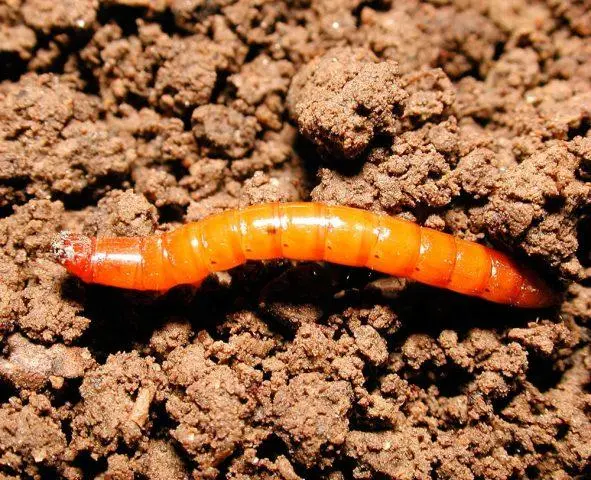
If signs of the appearance of a wireworm are found, it is necessary to immediately water the plantings with chemicals
Onion nematode
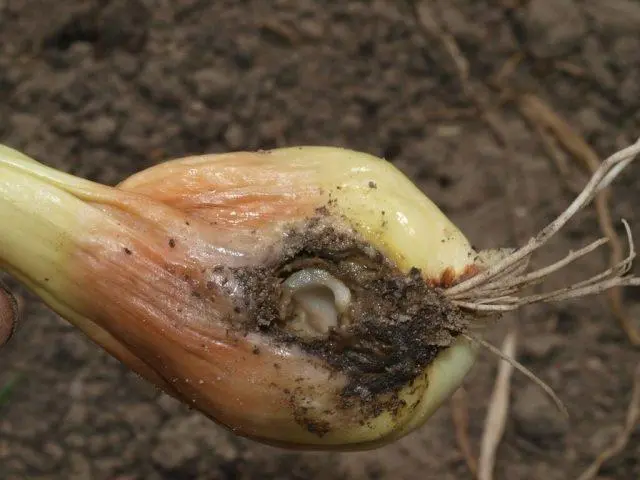
If a white worm wound up in the onion, it may be a nematode
This is a dangerous pest that can destroy plantings in just a few days. The body is small, up to 1,5-2 mm long. The color is white with a hint of yellowish. It feeds on plant tissue and lays eggs in it. Then, after 3-5 days, larvae appear from them, which cannot be seen with the naked eye.
Watering plantings with chemicals or other means is necessary already at the first symptoms:
- bulbs soften;
- feathers dry up and turn yellow;
- rhizomes rot;
- roots (from the side of the bottom) and husks fall off;
- the lower part of the stem rots;
- the surface of the heads is cracked.
TRIPS
A very dangerous pest that affects not only onion plantings, but also the crop after harvest (in the basement, cellar, and other premises). It is a small worm growing up to 1,3 mm. The color is brown or dirty yellow, with red eyes. Eggs are white, barrel-like. Thrips make laying in onion stalks, so watering should be done both under the root and the green part.
You can determine the invasion of this type of worm by the following signs:
- onion loses growth;
- stems turn yellow and change shape;
- seedlings begin to rot quickly;
- stripes of white or silver color are noticeable on the foliage;
- bulbs shrink.
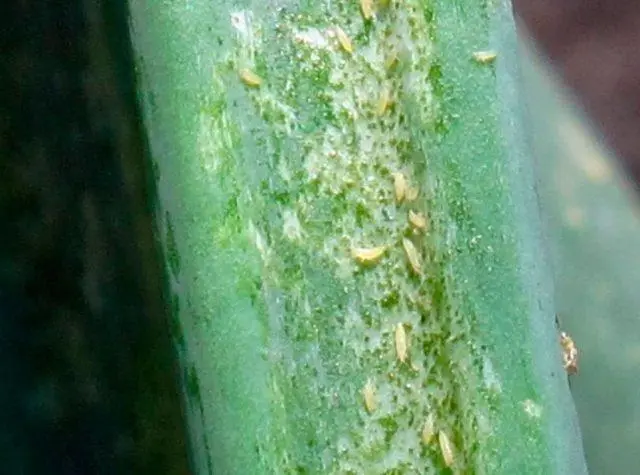
A characteristic feature of the pest is high fecundity
It gives the second generation in three weeks. Therefore, watering with special solutions should be several times during the spring-summer.
root mite
Another pest that resembles a worm. It affects onions, feeds on the pulp of the root crop, because of which the latter rots. The danger is associated with both the defeat of plantings and already harvested crops. Root mites are barely noticeable – the bodies are 1,0-1,1 mm long, the color is white, sometimes yellow.
They lay eggs (oval shape, white color) directly into the roots of the onion. Therefore, it is necessary to water carefully so that the solution penetrates deep into the soil. Larvae are formed after 15-20 days. During a cold snap, the worms may go into hibernation, but with the return of heat they become active again.

A bulb affected by a root mite quickly rots
Watering should be done at the first sign of an invasion:
- white bloom on foliage;
- drying, yellowing of feathers;
- loss of heads of normal shape;
- rot, the appearance of mold on the root, stems;
- falling off of the roots from the bottom (they die off).
Onion weevil
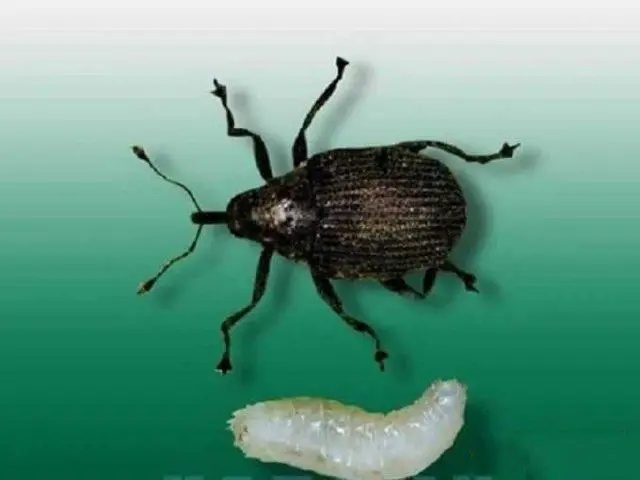
Among the worms that harm the onion, the danger is the weevil
It feeds on the juices of the stem, which is why the head stops developing. Adult individuals reach a length of 3 mm, the color is black, a longitudinal strip along the back is noticeable.
Already in early May, pests lay white eggs in onion foliage. At this point, planting should be watered using folk remedies or special preparations. Processing is intensified when obvious signs of invasion appear:
- the onion stops growing;
- arrows turn yellow and fade;
- irregularities are noticeable along the edges of the leaves;
- white spots appear on the stems.
Onion bun
This worm in length reaches no more than 7 mm. It has a greenish color with a hint of bronze and 2 stripes along the back of gray. It looks like a fly. In early May, hoverflies penetrate the surface layer of the soil and lay their eggs, including next to the onion. Worms will hatch from them in 7-10 days – larvae of a white, dirty shade. They begin to feed on the pulp, then go back to the soil for the winter.
Watering plants and soil with insecticides is necessary when the following signs appear:
- stems wither and turn yellow;
- plants stop growing
- the head softens, its middle turns black;
- because of the rotting of the onion, an unpleasant smell comes from the garden.
Onion moth
This is a dangerous pest that feeds on the stems and roots of onions, which leads to loss of yield. Mature individuals are a small butterfly (up to 1,5 mm) of a brown hue. Already in May, they lay yellow eggs in onion stems, and worms hatch from them in a week – larvae up to 1 cm long. Numerous brown warts are visible on the surface.
You need to water the plants at the moment when the first signs of invasion begin to appear:
- the onion stops growing;
- leaves wither;
- bulbs rot;
- longitudinal stripes are visible on the stems;
- arrows turn yellow and fade.
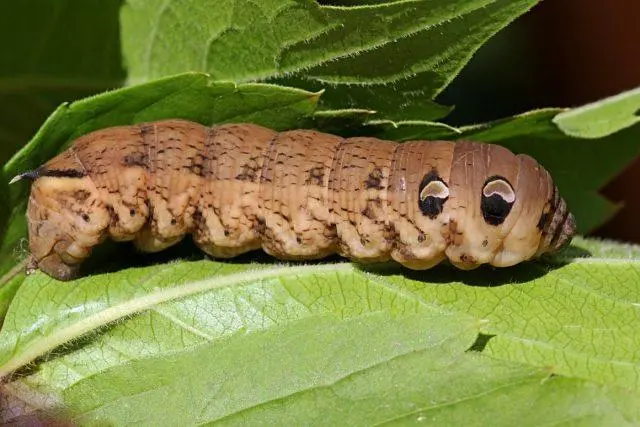
Onion moth caterpillar
How to get rid of worms in onions
If worms are wound up on the roots, in the green of the onion, it is necessary to start fighting them as soon as possible. Almost all pests are prolific, give several generations per season. Therefore, if nothing is done, a significant part of the crop will be lost.
To destroy the worms, plantings need to be watered with different solutions. The most effective means are chemicals. But they are not safe during the fruiting period. Therefore, along with chemical insecticides, biological preparations, as well as folk remedies, are also used. The main options are described in the following sections.
Chemicals
Chemical preparations (insecticides, acaricides) are the best means of destroying worms. The active ingredients are highly toxic, so one treatment is usually sufficient. To save the onion from the invasion of pests, it should be watered with such chemicals:
- “Muhoed”;
- “Medvetoks”
- “Zemlin”.
These funds are applied directly to the soil, i.e. you need to water the beds, and for prevention – and aisles. Also, the treatment of onions from worms is carried out with other insecticides (they spray the leaves):
- “Iskra DE”;
- “Fitoverm”;
- “Lens”.
Biological preparations
Unlike chemicals, biological preparations contain strains of bacteria and other microorganisms that destroy worms. Onions should be watered with such solutions at the fruiting stage, when it is no longer possible to use chemicals, and folk remedies are not effective enough.
The most effective biological insecticides and acaricides include:
- “Trichodermin”;
- “Metronidazole”;
- “Bitoxibacillin”.
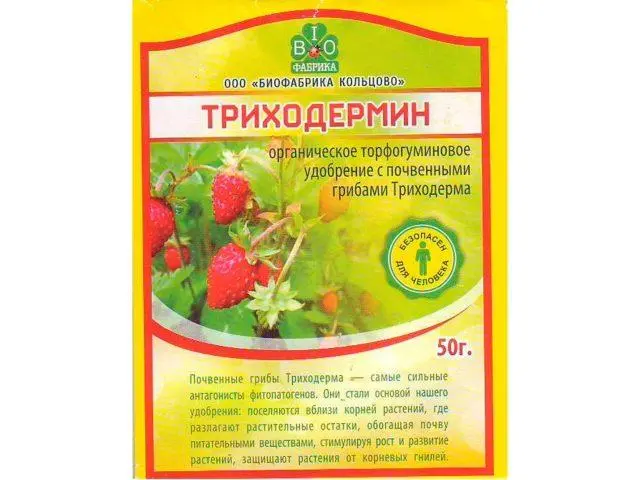
“Trichodermin” works as an insecticide and as a bacterial fertilizer
To water the onions from worms, the preparations are diluted according to the instructions, strictly observing the dosage. It is important to take into account the waiting times – they are quite short and amount to only a few days.
Folk remedies
You can also process onions from worms with folk remedies. They are indispensable when fruiting has already begun or the crop is grown on greens. The fact is that many chemicals are toxic, and waiting 20-30 days from the last watering (waiting time) is not always possible. In addition, folk remedies quite well help to cope in the early stages of the invasion.
Watering onions from worms is recommended with solutions and infusions prepared according to such recipes (the amount is given per 10 liters):
- Take 100-150 g of wood ash (vegetable ash is not suitable), dissolve in the specified volume. They insist a little and begin to water the plants from worms.
- Collect dandelion flowers (yellow), take 200 g and insist in 1 liter of water at room temperature for two days. Dilute in a bucket of water, filter and begin to water the onion from the worms.
- Another proven tool is to get 200 small shavings of laundry soap, dissolve in warm water, mix and start processing.
- You can also water the onions from worms with a solution of ordinary edible salt (300 g per bucket). But repeat the procedure is allowed no more than two times per season.
preventive measures
Getting rid of onion worms is sometimes much more difficult than preventing their invasion. To do this, you need not only to water the plants with various means, but also to follow other rules of agricultural technology:
- The all-rounder.
- Pickling onion sets.
- Soil disinfection for seedlings.
- Irrigation compliance.
- Planting next to the beds of marigolds, anise, dill and other plants with a fragrant aroma.

To prevent an invasion, onions should not be planted in one place for more than three years in a row.
Conclusion
Watering onions from worms is carried out after the appearance of mass shoots, and then as needed. If the invasion is observed during the fruiting period, it is recommended to use only biological preparations and folk remedies. In any case, you can harvest no earlier than three days after the last spraying.









